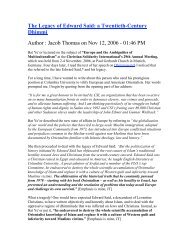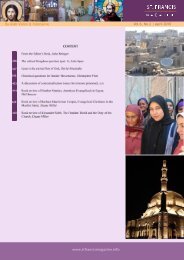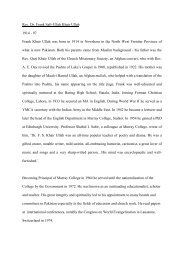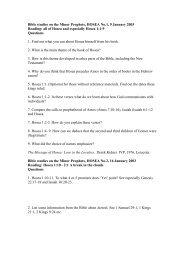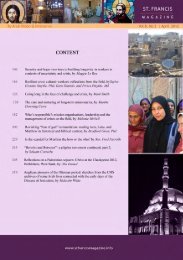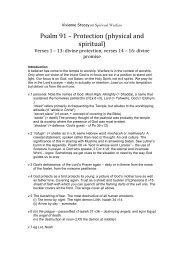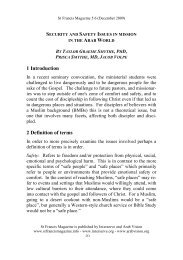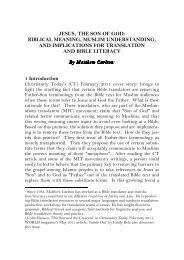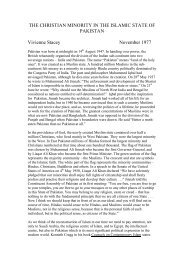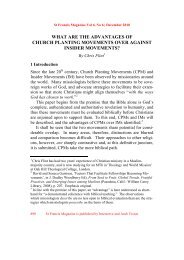download the pdf - St.Francis Magazine
download the pdf - St.Francis Magazine
download the pdf - St.Francis Magazine
You also want an ePaper? Increase the reach of your titles
YUMPU automatically turns print PDFs into web optimized ePapers that Google loves.
<strong>St</strong> <strong>Francis</strong> <strong>Magazine</strong> Vol 8, No 4 | August 2012<br />
which characterises C5 ministries. 19 Later Caldwell, writing under<br />
<strong>the</strong> name Higgins, supplemented <strong>the</strong>se analogies by appealing to<br />
what he suggested was a Pharisee-based movement evident in Acts<br />
15:5; 21:17ff (Higgins 2004: 158-159; 2007: 37). This paralleled<br />
Massey’s earlier alignment of C5 alongside Paul’s ministry in contrast<br />
to that of <strong>the</strong> Galatian Judaizers, seeing a parallel between <strong>the</strong><br />
Judaizers and any requirement that MBBs need to convert to ‘Christianity;’<br />
this, Massey claimed, many in <strong>the</strong> Islamic world viewed as a<br />
“godless Western institution” (Massey 1999: 191).<br />
Simultaneously seeking biblical precedents for C5 back across on<br />
<strong>the</strong> o<strong>the</strong>r side of <strong>the</strong> NT ethnic divide – that is, from within majority<br />
Judaism – Jameson and Scalevich (2000) suggested that <strong>the</strong> firstcentury<br />
negotiation by Jewish believers of <strong>the</strong>ir self-identity within<br />
wider Judaism holds out a model for C5 ministries. He cites Acts<br />
2:46; 3:1; 10:9; 21:20 and 24:14 in support of <strong>the</strong>ir claim. Seeing Peter’s<br />
appeals to <strong>the</strong> Old Testament in Acts 2 and 3 as paralleling<br />
MBBs making use of <strong>the</strong> Qur’an, <strong>the</strong>y extrapolated from Acts 21:20<br />
that “[s]imilarly, many twentieth-century Muslim believers are<br />
finding it necessary to maintain <strong>the</strong>ir distance from <strong>the</strong> traditional<br />
Christian community in order to stay within <strong>the</strong>ir Muslim context...<br />
to freely worship with <strong>the</strong>m... would destroy <strong>the</strong>ir credibility in<br />
<strong>the</strong>ir own community, as it would have for first-century Jewish believers.”<br />
(Jameson and Scalevich 2000: 36)<br />
This issue of IJFM closed 20 with Culver projecting ‘<strong>the</strong> Ishmael<br />
promise’ through <strong>the</strong> OT as far as <strong>the</strong> magoi in Mat<strong>the</strong>w 2 (Culver<br />
19 Lewis (2007: 75) judged extractionism to typify Western paradigms of church<br />
formation, in contrast to more communal approaches characterising insider<br />
movements.<br />
20 Also in this IJFM <strong>the</strong>med edition, Brown (2000a) raised important and longstanding<br />
questions surrounding Bible translation and interpretation, highlighting<br />
<strong>the</strong> phrase normally rendered in English as ‘son of God’. This, and o<strong>the</strong>r such<br />
matters are not specific to C5 or insider movements, and so are not pursued fur<strong>the</strong>r<br />
within this review. Parshall (2004: 64) described <strong>the</strong> translational issues<br />
surrounding ‘Son’ and ‘Messiah’ as simply “<strong>the</strong> newest contextual controversy to<br />
come down <strong>the</strong> pike.” Cf., elsewhere and variously on related translational<br />
questions, e.g., Massey (1998a; 2004b); Madany (2006); Nikides (2006a); Greer<br />
(2010), responding to Abernathy 2010).<br />
<strong>St</strong> <strong>Francis</strong> <strong>Magazine</strong> is a publication of Interserve and Arab Vision 464




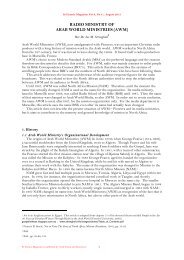
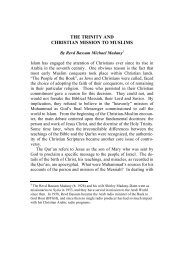
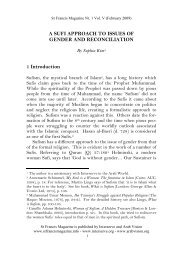
![Reflections on Surah Fatiha and the Lord's Prayer[1] - St.Francis ...](https://img.yumpu.com/49377951/1/184x260/reflections-on-surah-fatiha-and-the-lords-prayer1-stfrancis-.jpg?quality=85)
